Research Article - Journal of Drug and Alcohol Research ( 2022) Volume 11, Issue 10
Prevalence and Underlying Threats of Drug Abuse: A Case Study on Kathua District (Jammu & Kashmir)
Ankush Sharma1*, Ashwani Kumar1 and Rozi Sharma22Department of Environmental Science, University of Jammu, India
Ankush Sharma, Department of History, Central University of Punjab, India, Email: ankushsharma0123@gmail.com
Received: 03-Oct-2022, Manuscript No. JDAR-22-76555;;Accepted Date: Oct 24, 2022; Editor assigned: 05-Oct-2022, Pre QC No. JDAR-22-76555 (PQ); Reviewed: 19-Oct-2022, QC No. JDAR-22-76555; Revised: 24-Oct-2022, Manuscript No. JDAR-22-76555 (R); Published: 31-Oct-2022, DOI: 10.4303/JDAR/236201
Abstract
The present study analyzes the problem of drug abuse in the Kathua district of Jammu and Kashmir. The geographical location of the place is such that it is one of the driving factors of drug menace vis-à-vis a threatening factor for the national security. The paper tries to present a clear picture of the extent of drug abuse in the region and the concerns associated with it. It presents data from various government reports, newspapers, as well as the data collected from the Department of Psychiatry, Government Medical College, Kathua and District Police, Kathua. A survey is also conducted for the study with a sample size of 500 using random sampling. It uses pie charts and graphs to present data in a lucid manner. This study is an attempt to understand the causes of drug menace in the district and also suggesting the measures to address it.
Keywords
Drug abuse; Kathua district; Drug menace; Youth; Mental illness; National security
Introduction
The 21st century has witnessed massive progress in almost every field, enhancing the quality of human life. This is an unprecedented feat achieved by the humankind since the origin of life. Being at such a high point, having desires to climb the pinnacle, it is still struggling to fight the basic instincts of the human mind. The mind which has been the engine of human development is becoming the reason for its decline as well. In the pursuit of controlling the natural forces, humans have forgotten to focus on regulating own brain, leading to the problems of depression and drug abuse. There are many other causes of drug consumption, but the incapability to regulate one’s mind is prominent. Drugs are cause and consequence of mental illness, though they cause a variety of physical illnesses as well.
The Cambridge dictionary describes the word “Drug” as “any natural or artificially made chemical that is used as a medicine”. It is associated with different impacts on the body, physically or psychologically affecting the bodily functioning, mood, or consciousness. These drugs, meant to save life, can be life threatening if taken indiscriminately without a medical prescription [1]. One of serious concerns for the world is the popularity of drug abuse in the young population. The prime factors towards it are changing lifestyles, family structures, social media influences, competitiveness and incapability to accept failures. They are the generation who will soon have the responsibility to drive the world further, but the drug abuse is standing as an obstacle, especially for the countries like India, which are enjoying the demographic dividend.
This paper is divided into the following sections. The various terms associated with the drugs and a brief background presenting the numbers of those affected are discussed in section 1. The specific region of Kathua district (mapped through GIS), Jammu and Kashmir, along with its detailed literature review, is described in section 2. Section 3 deals with the research gap, objectives and methodology. The results of the study where the prevalence of drug abuse, and its causes and threats are discussed, dealt in section 4. To conclude the study, along with some of the suggestions, is the theme of section 5.
Terms associated
Drug abuse, drug dependence and drug addiction are the three terms mostly associated with the drug issue. Drug abuse is inappropriate use of drugs beyond the acceptable culturally sanctioned norms, whether in situation or quantity [2]. It is generally associated with the conscious consumption to enhance the capability, energy or the confidence. An athlete using drugs to enhance his stamina or a person using it for fighting depression is an example of drug abuse. It is the preliminary stage of drug dependence and further drug addiction.
Drug dependence is a physical process where the body or mind adapts to the drugs, considering it an essential part of it. As it does not get the drugs, it yearns intensively. On the other side, drug addiction is a psychological process, which involves a compulsive craving for drugs irrespective of adverse consequences [3].
The commonly used drugs are opioids, alcohol, cannabis, cocaine, tobacco, amphetamine etc. Opioids have three sub-categories: Opium includes doda, phukki, poppy husk; heroin includes brown sugar/smack and pharmaceutical opioids include various medications like cough syrups, capsules, tablets etc. Cannabis has bhang, ganja and charas [4]. Further, alcohol is consumed in various types: scotch, whisky, beer, vodka, gin, rum, etc. Other potential drugs are alprazolam, analgesics, petrol fumes, iodex, insecticides, snake venom and thinners [2].
BackgroundWith globalization, the world has become a village where every good and bad thing reaches to every corner with little unease. While enjoying its fruits, the world is largely ignorant of the subtle fact that it is equally exposed to the evils as well. If the modern technology is reaching everywhere, diseases like Covid-19, Swine flu are demonstrating their global presence. One such problem is drug menace; around 275 million people took drugs of various forms worldwide last year with a 22% increase from 2010. The demographic factors suggest this to further increase by 11% by 2030 [5]. After petroleum and arms, drug trafficking has grown to be the third largest industry with a turnover of around $ 500 billion [6,7]. As the money and power growing, it is becoming a vicious circle causing a drug pandemic.
Today, there is no corner of the world which is untouched by this problem. South Asia is a frontrunner in opiate use (1.1% of the population aged 15–64). It also surpasses the world in opioid use (2% of the adult population) [8]. In India, the situation is not different as well. It is emerging not just as a transit center, but the drug consumption is also spreading like cancer. The cases of opium have jumped from 860 to 1,494, heroin cases from 3,931 to 10,841, ganja cases from 8,130 to 27,234, hashish cases from 2,295 to 3,316 and cocaine from 100 to 134 between the times of 2015-2019 [9]. Men have been predominant in substance use, marking an increase in opioid consumption from 0.7 to 3.97 between the National surveys 2004 to National Survey 2018. The present magnitude of alcohol consumption in the Indian population is 14.6%, cannabis use is 2.83%, Opioids 2.06%, sedatives 1.08% and cocaine is 0.10% [4]. Further, there is a sharp rise in cases registered under the Narcotics Drugs and Psychotropic Substances (NDPS). In 2020, a total of 59,806 cases have been registered throughout throughout India [10].
The data discussed so far show the rising drug abuse in the country. However, it is not a uniform phenomenon, as the situation is grave in a few states, like Punjab, Maharashtra, Kerala, Uttar Pradesh and Jammu and Kashmir. An alarming trend is being seen in Jammu and Kashmir, where districts like Srinagar, Anantnag, Awantipora in the Kashmir division and Jammu, Kathua, Samba, Udhampur in Jammu division are becoming hotbeds. Being a border and a politically sensitive Union Territory (UT), it expresses an alarming state for the national security.
Study area
The study area of the present paper is the Kathua district of Jammu and Kashmir, northernmost Union territory of India (Figure 1). It is situated 32° 17′ to 32° 55′ North Latitude and 75° 70′ to 76° 16′ East longitude. The South-Eastern border of the district is shared by Punjab and North-Eastern by Himachal Pradesh. It also shares an international border with Pakistan on its South-Western side. It has an area of 2,502 Sq. Kms, an average elevation of 393 meters, a population of 6.16 Lacs, 5 assembly constituencies and 11 tehsils. Dogri is the regional language, while the Pahari languages are mostly used in the hilly parts of the district towards its East. English, Hindi, and Urdu are the primary medium of education. Although Kathua town is mostly a plain region, mountainous topography covers its majority of landmass.
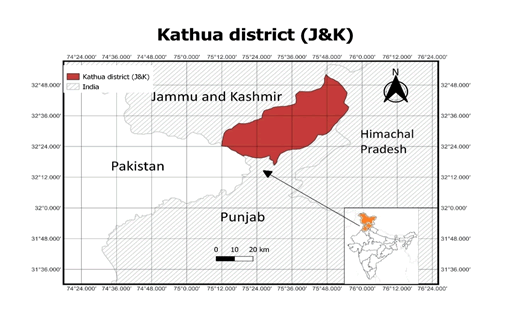
Figure 1: GIS based map of Kathua district.
Literature review of its geographical importance
Kathua is geographically placed in such a way that it is in the catchment area surrounded by drug infected regions. The drugs flow in the district from all its borders, i.e., Punjab, Himachal Pradesh, Pakistan and even from Kashmir. One of the probable reasons for such widespread drug menace in these regions is their proximity to the ‘Golden Crescent’, a drug trafficking zone which includes three countries: Iran, Afghanistan and Pakistan. Further, the porous international borders make the supplies and trade easy, with little hindrance [11].
Punjab, in the South-East of Kathua, is passing through an alarming state of drug abuse. Punjab government, in 2009, delivered a report to Punjab and Haryana High Court that “75% of Punjab’s youth and 65% of all families had been affected by drug addiction and that 30% of all inmates in Punjab’s jails were accused under the Narcotic Drugs and Psychotropic Substances Act” [12]. In 2015, the Punjab Opioid Dependence Survey, one if its own kind, found that 2,30,000 people in the state were drug users [13]. Punjab registered 6,909 NDPS cases, second highest in the country after Uttar Pradesh. However, it has the highest number of cases in proportional figures (22.9 per lakh population). Himachal Pradesh, another neighboring state of Kathua, has 20.9 per lakh population, second highest in the country [14].
Drugs enter Punjab through the borders of Amritsar, Tarn Taran, Gurdaspur, Ferozepur and Fazilka districts of Punjab and also through some neighboring states [15]. It is a policy paralysis and inability of enforcement agencies that drug flow is so rampant, which can be attributed to the lack of manpower, poor drug detection training and procedural delays [11]. This problem is largely affecting young and school going boys [6]. Peer pressure is an important factor for initiation of substance use; agricultural fields, river banks, old buildings and lonely places provide the safe spaces for drug abusers [16]. Females are no exception. They also consume opium, alcohol, and tobacco, though in small numbers [2]. An actual figure about prevalence of drug menace is difficult to determine, as it is a social stigma pulling people away from disclosing the real information [17]. Drug abuse is not a static process, its type and extent changes with time, provided the social, economic and psychological conditions of the people. [18]. Drug abuse and crimes have a strong link, though social and health issues like unemployment, inequalities and mental illness play an essential role in this context [19].
On the other side, the Kashmir valley is also assuming gargantuan dimensions with rising drug trafficking through Pakistan via LoC (Line of Control) and Afghanistan. According to a report, there is 1500% growth in patients seeking treatment for drug abuse in the hospitals in the Kashmir valley [20]. Around 70 thousand drugs addicts with approximately 31% women are there in the Kashmir division as per a report published by United Nations, Drug Control Programme (UNDCP) [21]. Easy availability of drugs has contributed hugely to the drug problem [22]. The failure of drug monitoring agencies and the nexus of chemists, the peddlers and the police, are pushing the drug abuse to another level [23]. Among the youth, drug abuse by a family member, lack of achievements in schools and poor esteem are prominent pushing factors towards alcohol and substance [24]. Besides that, the long term conflicts and violence in Kashmir have also been a prominent reason along with the unemployment [3]. It develops mental health disorders like depression, anxiety and stress, ultimately resulting in drug abuse [25]. Cannabis abusers are found to be more prone to mental health issues, including neurobiological disorders [26]. This has led to a vicious circle of mental illness and drug abuse.
Research gap and objectives
Punjab and Kashmir have become hotbeds of drug abuse, which can be cited as a reason of availability of extensive research literature. However, the drug problem in the Jammu division is largely untouched. Kathua district is experiencing an exponential rise of drug abuse. It needs attention of the research community to understand the scale of the problem and find valuable solutions before the things get worse. The current study will try to address these issues. Following are the research objectives of the study:
• To study the prevalence of drug menace in the Kathua district.
• To examine the factors encouraging the drug dependence.
• To highlight the possible threats posed by drug abuse.
• To provide the suggestions for fighting the drug problem.
Research Methodology
The study is based on the both primary survey and secondary sources. To understand the public perception regarding rising drug problem in the district, a pilot survey has also been conducted with a sample size of 500 by using a random sampling method. The data regarding cases registered under Narcotic Drugs and Psychotropic Substances (NDPS) Act is collected from District Police Headquarters, Kathua and National Crime Records Bureau (NCRB) reports. The data regarding In and Out-patient mental illness is collected from the Psychiatry department of Government Medical College (GMC), Kathua. Besides that, there are interviews conducted with the staff and doctors of Government Medical College (GMC), to understand the relation between drug abuse and mental illness. The secondary sources include various research papers, books, journals, national and international reports.
Results
We have discussed a good range of articles in this research regarding the reasons for drug abuse and the associated harm to the society in the regions of Punjab, Himachal Pradesh and the Kashmir Valley. This study, however, focused on the Kathua district of Jammu and provides the following results. The two major main themes that emerged are: (1) Prevalence of drug abuse, (2) Causes and threats.
Prevalence of drug abuse
The drug abuse is raging in the newly created Union Territory of Jammu and Kashmir. Around 1.31% of population use cannabis, 4.91% opioids, and 1.54% sedatives, 1.22% Inhalants, etc. Most of these intakes have a higher percentage than the national average. There are 25,098 people who inject drugs, exposing the high magnitude of drug abuse in the Union Territory [4].
Recently, a study revealed that around 6,00,000 people forming 4.6% of the population of Jammu and Kashmir are facing drug abuse related issues. Among them, 90% are of the age group 17-33 years [27]. In the recent data, released by NCRB, there are around 1,222 cases registered under the NDPS Act [10]. Jammu and Kashmir have the highest numbers among the Union Territories of India. Out of 1,222 cases, the Jammu division accounted for 573 cases.
Dividing this number into districts, Kathua had 61 cases, one of the highest among all districts. Further, a mammoth figure of 2,51,717 intoxicants got recovered in Kathua district [28].
As per the data revealed by the district police Kathua, there is an increasing trend of NDPSA cases from 2017 to 2021 (Figure 2). There is a slight reduction in 2020, but it again accelerated to 89 in 2021. The figures of 2022 project an alarming trend as there are already 35 cases up to 3rd June 2022. If it continues at the same pace, it may lead up to cross previous years’ records. Besides that, we need to consider the fact that these numbers, especially from 2020-2022, are from the restricted period of Corona pandemic. Hence, the situation might be worse than the data is projecting.
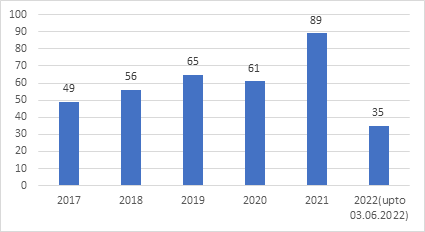
Figure 2: NDPS Act cases registered in Kathua district.
The expanse of drug issue in Kathua district is evident from the wide coverage it has got in national media. It is not a local or small problem anymore. Since 2019, Kathua has appeared in almost all national newspapers for the infamous drug abuse. In 2022 alone, there are a dozen reports and articles published. Business Standard published a report on April 2019 [29], Tribune India on Feb 2020 [30], Outlook India on May 2022 [31] and the list goes on along with the huge coverage in state newspapers.
Apart from newspapers, there is a general perception among the public about the increase in drug abuse, as revealed by the survey conducted for this study. When asked about the current situation of drug abuse, around 86% respondents believed that drug problem has increased in Kathua as shown in Figure 3. Most of them (64%) believed that it is equally prevalent in rural and urban regions. However, 14% believed rural areas and 22% believed urban areas are most affected (Figure 4).
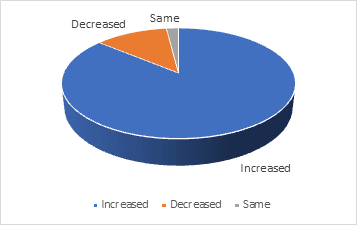
Figure 3: Drug problem in Kathua.
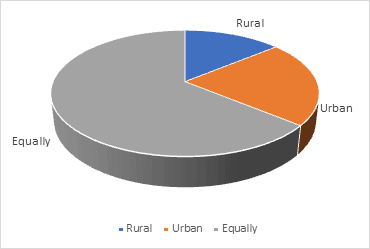
Figure 4: Regions most affected.
The Annual Report of Narcotic Control Bureau provides various trends and patterns of drug trafficking in India. The maps shown in Figures 5-10 provide trafficking routes of various drugs in India [14]. Kathua, as marked in maps, is located in all the trafficking routes, which itself is an evidence of the scale of prevalence of drugs in the region.
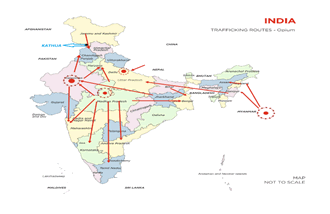
Figure 5: Trafficking routes of Opium, as per Annual report NCB, 2020.
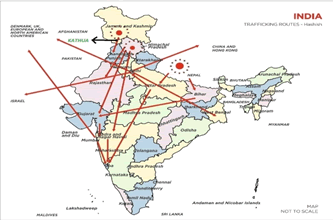
Figure 6: Trafficking routes of Hashish, as per Annual report NCB, 2020.
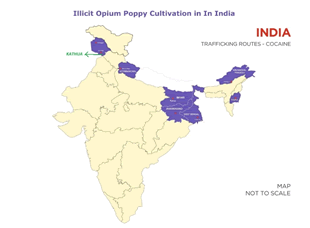
Figure 7: Trafficking routes of Cocaine, as per Annual report NCB, 2020.
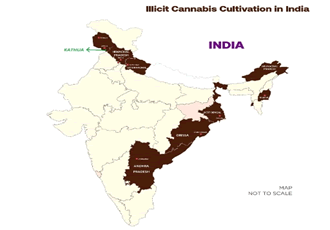
Figure 8: Illicit Cannabis Cultivation in India, as per Annual report NCB, 2020.
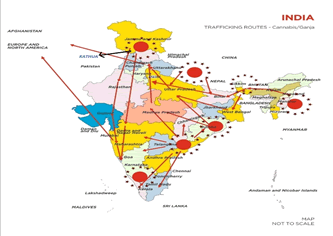
Figure 9: Trafficking routes of Cannabis/Ganja, as per Annual report NCB, 2020.
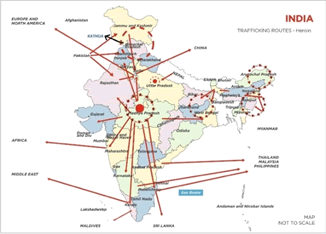
Figure 10: Trafficking routes of Heroin, as per Annual report NCB, 2020.
Causes and threats
The popularity of drugs in the youth is unprecedented in the current times. The changing lifestyle and emerging industrialization and urbanization are important factors playing towards it. The rise of individualism and competitiveness has taken people away from society. Competitions and failures are the prime reasons for depression and stress; individualism ensures lack of much needed support during mental illnesses, which is then fulfilled by drugs. Other reasons include unemployment; peer-pressure, drug and thrill-seeking culture are rolling towards drug abuse.
The easy availability of drugs in Kathua is a huge problem. From Punjab, Himachal Pradesh, Kashmir to even Pakistan, drugs flow from all directions. The smuggling activity also has the involvement of people from few border regions. Not just smuggling, they are also the victims of drug abuse. In a question asked in the survey conducted for this study, about Kathua’s border with Punjab and Pakistan being a cause of drug problem. Around 70% respondent considered it as an important reason for the drug menace in Kathua; 24% were not sure about it and the rest 6% said ‘No’ (Figure 11).
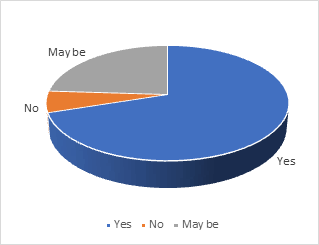
Figure 11: Survey result, Border with Punjab and Pakistan.
Enforcement agencies often evade from booking drug abuser under NDPS Act due to lack of expertise in handling them; they fear custodial death can risk their job. Drug addict inmates in many jails of Punjab are provided with the drugs within jails [15]. This is not a unique phenomenon to Punjab; Jammu and Kashmir jails have also been under questions for the same. In the survey, people were asked whether the enforcement agencies are responsible for drug menace in Kathua. Around 54% said ‘Yes’, 40% said ‘May be’ and the others said ‘No’ (Figure 12). The survey showed that there is a good proportion of population, which either side with enforcement agencies or doesn’t take stand without being clear on the issue. Though the survey reveals that many respondents are unsure of the causes, there is a majority which consider both the factors responsible for drug menace as shown in Figures 11 and 12. Several respondents alleged that the enforcement agencies don’t destroyed of the drug seized; instead they get recirculated in the society.
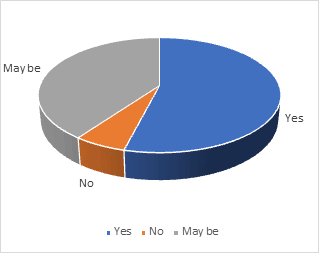
Figure 12: Survey result, Failure of enforcement agencies.
Narco-politics has been an important factor in the promotion of drugs in various regions. The Police-Politician- Peddler Nexus in Punjab was highlighted by Shashi Kant, a retired Indian Police Service officer [15]. Same is suspected by many social activists in Kathua. Many local politicians can be involved in it to get popularity amongst the youth and get help in the elections. Besides that, the media and internet have played a crucial role in taking the drugs into the rural hilly regions of Kathua. First, the glorification of drugs in movies and social media creates the market by popularizing them amongst the youngsters. Then, the social media connects the drug users and smugglers irrespective of their location beyond the vigilant eye of police. The rising rural drug problem is more dangerous due to low police check, illiteracy and lack of awareness among common people. In a survey conducted in Jammu district, 56.3% people didn’t know about the de-addiction centers in the city [32]. It is very true for Kathua district as well, which is evident from the fact that there is just one de-addiction center in the whole district, and it remains empty most of the times. It also implies that people lack trust in the de-addiction centres because of the insufficiency of infrastructure and expertise.
In a report (Figure 13), it was revealed that only 25% Alcohol Dependent who wanted to quit Alcohol received treatment and 21% among they were hospitalized; as per Figure 14, 25% drug dependent received treatment, among which 44% were hospitalized [4]. These figures highlight that the issue of drug abuse is still not addressed at the institutional level. Below are the figures taken from the report mentioned above.
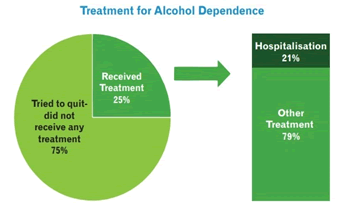
Figure 13: As per the report of Magnitude of Substance use in India by MOSJ&E, 2019.
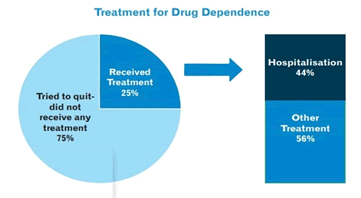
Figure 14: As per the report of Magnitude of Substance use in India by MOSJ&E, 2019.
Indian scriptures also talk about an intoxicant drink called ‘Somras’. The Cannabis (Bhang) is regarded as the favourite drink of Lord Shiva [1]. The picturization of Lord Shiva with the intoxicants has become a famous theme of online wallpapers and paintings, mostly popular in the youth. Shiva is associated with various aspects, from drinking cannabis to poison and from being violent to a meditative being; each aspect has a meaning. But the youth is attracted to intoxicant forms without understanding the subtle meaning. Nonetheless, we need to recognize the fact that most of the drug infected states like Jammu and Kashmir, Punjab and North-eastern states have majority a non-Hindu population. Hence, it may not be a substantive cause, though it has a potential to impact.
Mental health is becoming an important cause and consequence of drug abuse. According to the Outpatient Mental illness data of Government Medical College (GMC) Kathua, there is a sharp jump in mental illness cases from 2019 to 2021 (Figure 15). The data of the current year is also showing a high trend. Along with that, an important fact needs acknowledgement that the figures of 2020-2022 are from the Corona pandemic period, whereby people were afraid of visiting hospital until some emergency occurs. Most patients in hospitals were of Corona infection. Hence, the data of mental illness patients visiting hospitals cannot be considered synonymous with the actual number of patients in the district. In-patients in the year 2019 are zero, which shows a slight increase to 13 in 2020, 73 in 2021 and 82 in the current year till June (Figure 16).

Figure 15: Number of Mental illness patients (excluding IPD) in GMC Kathua (does not include the data of months, January to April (2019).
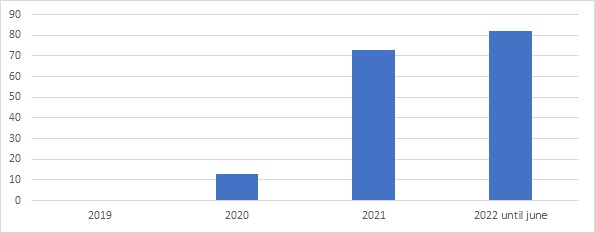
Figure 16: Number of Mental illness In-patients in GMC Kathua.
The Drug abuse patients indicate a similar rising pattern as mental illness patient. Mental illness patients have a considerable proportion of drug abuse related patients. The visits by drug abuse related patients in the hospital have been high in 2019, i.e. pre-Covid times (Figure 17). It has shown decline, but it is because of the Covid crisis. The numbers in June show a rising trend again. There were minimal In-patients in drug abuse related cases. The complete data is provided in the Tables 1-4. These figures may not represent the real picture because of the pandemic. Also, these issues are still not preferred by the people to be treated in the hospitals. Mental illness is yet to be recognized as a disease among the masses, especially in the rural regions. Still, the rising drug abuse and mental health cases showing in the hospitals are a concern as they indicate the grim picture brewing outside the hospitals. The mental illness has a potential to catalyze the drug abuse, posing a huge threat to the human capital of the region.
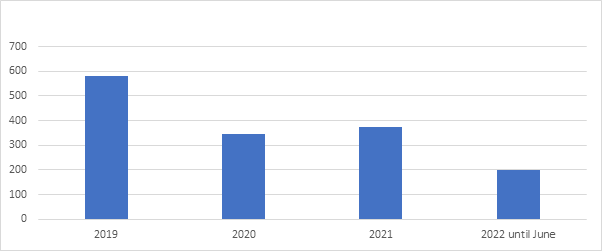
Figure 17: Number of Visits by Drug abuse patients (does not include the data of months, January to April (2019).
Table 1: Number of mental illness patients (Inpatients & Outpatients separately) and Drug abuse patients of year 2019 (month wise).
| Months | Cases | IPD | Visits by Drug Abuse Patients | |||||
|---|---|---|---|---|---|---|---|---|
| Male | Female | Total | Male | Female | Total | Drug Abuse Patients | ||
| April | _ | _ | _ | Nil | Nil | Nil | 0 | 71 |
| May | 148 | 168 | 316 | Nil | Nil | Nil | 0 | 54 |
| June | 242 | 205 | 447 | Nil | Nil | Nil | 0 | 44 |
| July | 367 | 408 | 775 | Nil | Nil | Nil | 0 | 84 |
| August | 201 | 268 | 469 | Nil | Nil | Nil | 0 | 88 |
| September | 270 | 357 | 627 | Nil | Nil | Nil | 0 | 76 |
| October | 292 | 322 | 614 | Nil | Nil | Nil | 0 | 84 |
| November | 318 | 355 | 673 | Nil | Nil | Nil | 0 | 57 |
| December | 276 | 238 | 514 | Nil | Nil | Nil | 0 | 43 |
| Total | 2114 | 2321 | 4435 | 581 | ||||
| Source: Government Medical College, Kathua | ||||||||
Table 2: Number of mental illness patients (Inpatients and Outpatients separately) and Drug abuse patients of year 2020 (month wise)
| Months | Cases | IPD | Visits by Drug Abuse Patients | |||||
|---|---|---|---|---|---|---|---|---|
| Male | Female | Total | Male | Female | Total | Drug Abuse Patients | ||
| January | 239 | 213 | 452 | 2 | 0 | 2 | 1 | 49 |
| February | 434 | 303 | 737 | 2 | 0 | 2 | 5 | 60 |
| March | 595 | 382 | 977 | 4 | 0 | 4 | 2 | 45 |
| April | 126 | 108 | 234 | 0 | 0 | 0 | 1 | 23 |
| May | 308 | 242 | 550 | 0 | 0 | 0 | 0 | 19 |
| June | 237 | 315 | 552 | 0 | 0 | 0 | 0 | 35 |
| July | 153 | 207 | 360 | 0 | 0 | 0 | 0 | 24 |
| August | 218 | 274 | 492 | 0 | 0 | 0 | 1 | 17 |
| September | 295 | 433 | 728 | 1 | 1 | 2 | 3 | 16 |
| October | 274 | 386 | 660 | 0 | 0 | 0 | 0 | 17 |
| November | 296 | 338 | 634 | 0 | 0 | 0 | 2 | 15 |
| December | 256 | 309 | 565 | 1 | 2 | 3 | 0 | 27 |
| Total | 3431 | 3510 | 6941 | 10 | 3 | 13 | 15 | 347 |
| Source: Government Medical College, Kathua | ||||||||
Table 3: Number of mental illness patients (Inpatients & Outpatients separately) and Drug abuse patients of year 2021 (month wise).
| Months | New Cases | Old Cases | IPD | Visits by Drug Abuse Patients | ||||||||
|---|---|---|---|---|---|---|---|---|---|---|---|---|
| Male | Female | Total | Male | Female | Total | Total Patients | Male | Female | Total | Drug Abuse Patients | ||
| January | 119 | 83 | 202 | 178 | 136 | 314 | 516 | 4 | 0 | 4 | 0 | 15 |
| February | 179 | 136 | 315 | 264 | 208 | 472 | 787 | 4 | 2 | 6 | 1 | 14 |
| March | 324 | 246 | 570 | 175 | 205 | 380 | 950 | 2 | 2 | 4 | 5 | 12 |
| April | 131 | 112 | 243 | 75 | 116 | 191 | 434 | 8 | 2 | 10 | 4 | 17 |
| May | 109 | 69 | 178 | 63 | 68 | 131 | 309 | 0 | 0 | 0 | 3 | 11 |
| June | 163 | 121 | 284 | 62 | 44 | 106 | 390 | 3 | 1 | 4 | 1 | 15 |
| July | 144 | 189 | 333 | 85 | 120 | 205 | 538 | 1 | 1 | 2 | 1 | 28 |
| August | 295 | 182 | 477 | 128 | 177 | 305 | 782 | 3 | 1 | 4 | 2 | 29 |
| September | 221 | 291 | 512 | 162 | 206 | 368 | 880 | 5 | 4 | 9 | 2 | 34 |
| October | 183 | 223 | 406 | 207 | 217 | 424 | 828 | 7 | 4 | 11 | 4 | 39 |
| November | 307 | 265 | 572 | 96 | 127 | 223 | 795 | 4 | 5 | 9 | 2 | 98 |
| December | 187 | 282 | 469 | 196 | 200 | 396 | 865 | 4 | 6 | 10 | 2 | 64 |
| Total | 2362 | 2199 | 4561 | 1691 | 1824 | 3515 | 8076 | 45 | 29 | 73 | 27 | 376 |
| Source: Government Medical College, Kathua | ||||||||||||
Table 4: Number of mental illness patients (Inpatients & Outpatients separately) and Drug abuse patients of year 2022 until month June.
| Months | New Cases | Old Cases | IPD | Visits by Drug Abuse Patients | ||||||||
|---|---|---|---|---|---|---|---|---|---|---|---|---|
| Male | Female | Total | Male | Female | Total | Total Patients | Male | Female | Total | Drug Abuse Patients | ||
| January | 186 | 148 | 334 | 173 | 223 | 396 | 730 | 2 | 1 | 3 | 2 | 25 |
| February | 163 | 208 | 371 | 186 | 230 | 416 | 787 | 9 | 6 | 15 | 1 | 32 |
| March | 322 | 253 | 575 | 362 | 233 | 595 | 1170 | 19 | 5 | 24 | 4 | 31 |
| April | 112 | 132 | 254 | 150 | 189 | 339 | 593 | 6 | 7 | 13 | 3 | 18 |
| May | 178 | 278 | 456 | 196 | 282 | 478 | 934 | 3 | 6 | 9 | 5 | 57 |
| June | 207 | 226 | 433 | 268 | 368 | 630 | 1063 | 11 | 7 | 18 | 1 | 37 |
| Total | 1168 | 1245 | 2413 | 1335 | 1525 | 2860 | 5273 | 50 | 32 | 82 | 16 | 200 |
| Source: Government Medical College, Kathua | ||||||||||||
Besides the mental illness, the drug abuse has a direct relation with other illegal activities. As per the data provided by District Police Kathua, there is a direct relation between NDPS cases and theft cases in the district (Figure 18). When the NDPS cases are rising, theft cases rise as well, suggesting that drug abuse is not an isolated problem. The crime rate also shows an increasing trend, even when there was a lockdown during the Covid period (Figure 19). The drug problem brings many other issues, creating a threat to the overall development of the region.
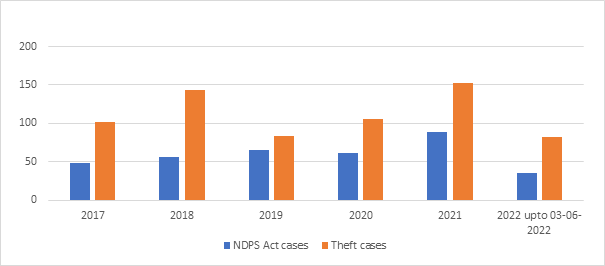
Figure 18: Number of NDPS Act and Theft cases registered in Kathua district.
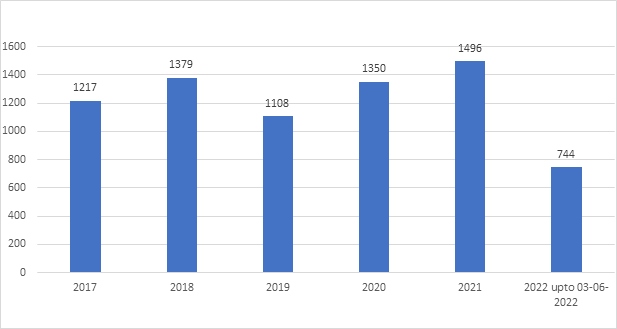
Figure 19: Total crime cases registered in Kathua district.
Kathua, being a border district and also a part of Jammu and Kashmir, a sensitive Union Territory needs to fight drug menace urgently as it raises the concerns regarding national security. It has so far remained one of the most peaceful districts of Jammu and Kashmir. Any disturbance here is a threat to the stability of the whole region. It can have a domino effect in nearby districts and states as well. When asked about the drug menace as a threat to national security, 88% respondents answered with ‘Yes’ (Figure 20). The border routes are not only used for drug trafficking but also for infiltration of arms and terrorists. Many attacks in Kathua are carried out by terrorists after crossing the border. The involvement of border villages in the trafficking business also has concerns regarding the potential increase in religious extremism.
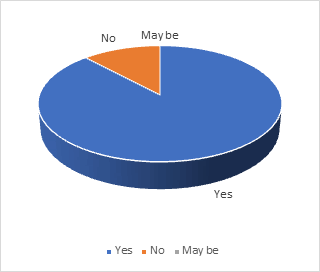
Figure 20: Survey result, Threat to national security.
The young population is the soul of any country. If it is not in the right direction, not just the individual families or a society, but the entire country will be derailed. These problems need prevention and cure at the same time without waiting for the things to appear too draconic to act.
Discussion
The study discussed above focused on the drug abuse and their causes in the border district, Kathua. Various works referred to are related to drugs and Jammu and Kashmir in a wider scope, where the specific case studies are often been ignored. Thus, there is a need to target the specific regions so that the monitoring of both causes and treatments can be done effectively. The limitation of this study is the age group of the population used as a sample i.e., only the young age group, who are directly involved in the drugs, are focused. However, it provides a base for the future researches dealing with spatial analysis of drug issues. Few suggestions are also highlighted to curb the drug menace in the region.
SuggestionsDrug menace in Kathua needs an urgent attention from the government and the community. The borders and Coasts need to be protected along with fighting the corruption in the border forces. There is also a need for cooperation with the neighbouring countries like Afghanistan, Bangladesh, Bhutan, Myanmar and Pakistan [33]. Enforcement agencies need to be more vigilant and trained to tackle such cases. They must make sure that drug smugglers cannot roll out their activities freely. They should be punished as per law and meanwhile the jails should not be allowed to become a space for drug abusers. Along with the policy formation, there is an urgent call for strict policy implementation on the grounds.
There is just one rehabilitation center in the entire Kathua district, which has 11 tehsils and over 6 Lakh populations [34]. Hence, there is need of at least one center in each tehsil along with the awareness among people about them. The facilities and expertise should also be imparted to the workers and the specialists for their proper functioning, to establish trust among people. Government institutions need to focus on capacity building to ensure a quality service delivery; so that drug addicts and their families could believe that their problem can be reversed. Recently, the Ministry of Social Justice and Empowerment has suggested that drug users caught with small quantities should be treated as victims, not culprits. They are to be sent to compulsory rehabilitation and treatment rather than jail [35]. It is supported by numerous studies that treating drug offenders can help reduce substance abuse and reduce associated criminal behavior [36]. This suggestion of ministry is welcomed, but there is a need for rehabilitation centers and trained staff, otherwise it would end up as a blunder. The creation of rehabilitation centers has also been suggested by the Ministry of Social Justice and Empowerment [37].
With the rising trend of drug abuse, preventive measures are equally important. Community involvement is immensely required for preventive education and awareness among people, especially youth. School and College students need to lead the drug awareness initiatives and they are required to be motivated to form voluntary organizations to work for the cause among their mates and society. As peer pressure forces one to choose drugs, the same peer pressure needs to be created to force them to stay away from drugs. In this regard, media and movies have to play a positive role by not allowing their platforms to be used for glorifying drug abuse.
Along with that, there is a need for better facilities of sports, libraries, drama theatres etc. to involve the youth in the games and other curricular activities. The pleasant and peaceful natural environment of Kathua possesses a great scope for promotion of Yoga by building Yoga centers attracting people from all ages. It has a tourism potential as well. Yoga and related therapies are both the prevention and cure for not just drug addicts, but mental illnesses as well. They are found effective in Nicotine-use disorders [38]. Every panchayat should be encouraged to have at least one Yoga center. The mantra chanting, especially with the sound ‘Om’, needs to be encouraged among students as it has been proven a stress releasing practice [39]. Along with these gifts of Indian culture, meditation cannot be ignored. It has the peaceful and calming effect on brain. Transcendental meditation has shown promising results by discouraging drug users from consuming drugs and even changing their attitude to work towards discouraging others from abusing drugs [40].
At last, the community participation and effective working of enforcement agencies can vanish this evil from the society in a small period. Also, it is high time to realize 5th target of 3rd Sustainable Development Goal, which says “strengthen the prevention and treatment of substance abuse, including narcotic drug abuse and harmful use of alcohol.”
Conclusion
The study discussed above focused on the drug abuse and their causes in the border district, Kathua. Various works referred to are related to drugs and Jammu and Kashmir in a wider scope, where the specific case studies are often been ignored. Thus, there is a need to target the specific regions so that the monitoring of both causes and treatments can be done effectively. The limitation of this study is the age group of the population used as a sample i.e., only the young age group, who are directly involved in the drugs, are focused. However, it provides a base for the future researches dealing with spatial analysis of drug issues. Few suggestions are also highlighted to curb the drug menace in the region.
SuggestionsDrug menace in Kathua needs an urgent attention from the government and the community. The borders and Coasts need to be protected along with fighting the corruption in the border forces. There is also a need for cooperation with the neighbouring countries like Afghanistan, Bangladesh, Bhutan, Myanmar and Pakistan [33]. Enforcement agencies need to be more vigilant and trained to tackle such cases. They must make sure that drug smugglers cannot roll out their activities freely. They should be punished as per law and meanwhile the jails should not be allowed to become a space for drug abusers. Along with the policy formation, there is an urgent call for strict policy implementation on the grounds.
There is just one rehabilitation center in the entire Kathua district, which has 11 tehsils and over 6 Lakh populations [34]. Hence, there is need of at least one center in each tehsil along with the awareness among people about them. The facilities and expertise should also be imparted to the workers and the specialists for their proper functioning, to establish trust among people. Government institutions need to focus on capacity building to ensure a quality service delivery; so that drug addicts and their families could believe that their problem can be reversed. Recently, the Ministry of Social Justice and Empowerment has suggested that drug users caught with small quantities should be treated as victims, not culprits. They are to be sent to compulsory rehabilitation and treatment rather than jail [35]. It is supported by numerous studies that treating drug offenders can help reduce substance abuse and reduce associated criminal behavior [36]. This suggestion of ministry is welcomed, but there is a need for rehabilitation centers and trained staff, otherwise it would end up as a blunder. The creation of rehabilitation centers has also been suggested by the Ministry of Social Justice and Empowerment [37].
With the rising trend of drug abuse, preventive measures are equally important. Community involvement is immensely required for preventive education and awareness among people, especially youth. School and College students need to lead the drug awareness initiatives and they are required to be motivated to form voluntary organizations to work for the cause among their mates and society. As peer pressure forces one to choose drugs, the same peer pressure needs to be created to force them to stay away from drugs. In this regard, media and movies have to play a positive role by not allowing their platforms to be used for glorifying drug abuse.
Along with that, there is a need for better facilities of sports, libraries, drama theatres etc. to involve the youth in the games and other curricular activities. The pleasant and peaceful natural environment of Kathua possesses a great scope for promotion of Yoga by building Yoga centers attracting people from all ages. It has a tourism potential as well. Yoga and related therapies are both the prevention and cure for not just drug addicts, but mental illnesses as well. They are found effective in Nicotine-use disorders [38]. Every panchayat should be encouraged to have at least one Yoga center. The mantra chanting, especially with the sound ‘Om’, needs to be encouraged among students as it has been proven a stress releasing practice [39]. Along with these gifts of Indian culture, meditation cannot be ignored. It has the peaceful and calming effect on brain. Transcendental meditation has shown promising results by discouraging drug users from consuming drugs and even changing their attitude to work towards discouraging others from abusing drugs [40].
At last, the community participation and effective working of enforcement agencies can vanish this evil from the society in a small period. Also, it is high time to realize 5th target of 3rd Sustainable Development Goal, which says “strengthen the prevention and treatment of substance abuse, including narcotic drug abuse and harmful use of alcohol.”
Acknowledgements
We are grateful to all people who helped us in writing this article, especially Government Medical College, Kathua and District Police, Kathua, for providing the required information.
Conflict of Interests
Authors have no conflict of interest to declare.
Funding Sources
All the costs, tools, and necessary facilities for writing this article were provided by the authors themselves.
References
- J. Dua, The problem of drug addiction in india: Its consequences and effective measures, JDDT, 12(2022), 159-163.
- D. Mohan, K.R. Sundaram, H.K. Sharma, A study of drug abuse in rural areas of Punjab (India), Drug Alcohol Depend, 17(1986), 57-66.
[Crossref] [Google Scholar] [PubMed] [ResearchGate]
- M.M. Naqshbandi, Drug addiction and youth of Kashmir, International NGO Journal,7(2012), 84-90.
- Ministry of Social Justice and Empowerment, Magnitude of substance use in India, National Drug Dependence Treatment Centre, AIMS (2019), New Delhi.
- United Nation Office on Drugs and Crime, World drug report 2021, United Nations Publication.
- K. Dhillon, Alcohol and drug dependence among rural youth in Bathinda district of Punjab, JMSCR, 3(2015), 7027-7032.
- B. Sharma, A. Arora, K. Singh, H. Singh, P. Kaur, Drug abuse: Uncovering the burden in rural Punjab, JFOA, (2017), 558–562.
[Crossref] [Google Scholar] [Pubmed] [ResearchGate]
- United Nations, International narcotics control board: Report 2021, United Nations Publication, (2022),Vienna.
- Ministry of Home Affairs, Annual Report 2019-20,Narcotics Crime Bureau, New Delhi.
- Ministry of Home Affairs, Crimes in India 2020, National Crime Records Bureau, New Delhi.
- S. Kaur, The ‘Drug Menace’ in Punjab: Causes, consequences and policy challenges, JSPS,28(2021), 41-49.
- Sahni, The border war with drugs, The Tribune, (2019).
- D. Jain, Six charts that show the seriousness of Punjab’s drug problem, Livemint, (2018).
- Ministry of Home Affairs, Annual report 2020-21,Narcotics Crime Bureau. New Delhi.
- R.K. Arora, V. Kaura, War on drugs: Challenges for the Punjab government, ORF BRIEF, 176(2017), 1-10.
- Kaur, S.K. Maheshwari, A. Sharma, Trends and patterns of drug abuse in select population of Punjab in year 2016-2017, IJPN, 15(2018), 13-16.
- K. Kaur, Drug abuse! problem is intense in Punjab, India, H Bio Rev,6(2017), 20-29.
- B. Lal, G. Singh, Drug Abuse in Punjab, Br J Addict, 74(1979), 411-427.
- K. Singh, Study on drug abuse in Punjab (India), Proceedings of ISER, (2018), 7-10.
- Z. Majid, In three years, Kashmir witnesses 1500% increase in drug abuse, Deccan Herald, (2021).
- S.A. Bhat, N. Imtiaz, Drug addiction in Kashmir: Issues and challenges, J Drug Abuse, 3(2017), 1-3.
- T. Sidiq, B.A. Bhat, Nusrat, F.A Wani, Drug addiction causes and awareness among people of Pulwama District of Jammu and Kashmir state, Saudi J Biomed Res,1(2016), 30-33.
- B. Ahmad, T. Sidiq, Awareness of drug addiction among college students of Kashmir Valley, IJMPR, 1(2015), 01-14.
- H. Azim, Case studies of drug abused youth of Kashmir valley, Int J Home Sci, 5(2019), 78-81.
- M.A. Malla, Substance abuse and mental health disorder among the youth living in conflict environment, JMHHB, 1(2021), 12-22.
- I.A. Wani, B. Singh, Mental health and cannabis abusers of kashmir valley, J Psy & Psychothe, 7(2017), 1-5.
- Lone, 600,000 youngsters in Jammu and Kashmir have become drug addicts: Study,Wionews, (2021).
- M. Verma, Jammu, Samba, Kathua, Udhampur distts turn into hotbed of drug abuse, Daily Excelsior, (2022).
- B. Standard, 15 nabs suspected drug addicts from two Kathua villages, Bussiness Standard, (2019).
- S. Pathak, Drug menace spreads its tentacles in hilly areas, Tribune India, (2020).
- The problem of drug addiction in india: Its consequences and effective measures
- S. Manzer, S. Dubey, H.A. Bhat, Drug addiction in jammu district-A sociological study, AGU int j res, 5(2017), 600-603.
- P. Das, Drug-trafficking as a non-traditional security threat: Emerging trends and responses, Artha-J Soc Sci, 8(2019), 1-23.
- Census of India, Kathua District: Population 2011, Office of the Registrar General & Census Commissioner, New Delhi.
- The Times News Network, Treat users with small quantity of drugs as victims, not culprits, Times of India, (2021).
- R.K. Chandler, B.W. Fletcher, N.D. Volkow, Treating drug abuse and addiction in the criminal justice system: Improving public health and safety, JAMA,301(2009), 183–190.
- Ministry of Social Justice and Empowerment, Annual Report 2021-22, Government of India.
- P.P. Kuppili, A. Parmar, A. Gupta, Y.S. Balhara, Role of yoga in management of substance-use disorders: A narrative review, JNRP, 9(2018), 117–122.
- B.K. Surlya, M. Jain, R. Priyamvada, M.S. Chandel, S. Chalak, Effect of om mantra chanting during examination stress in students, IJMBS, 4(2020), 210-212.
[Crossref] [ResearchGate]
- H. Benson, R.K. Wallace, Decreased drug abuse with transcendental meditation-A study of 1,862 subjects, In Meditation, (2017), 97-104.
Copyright: © 2022 Ankush Sharma, et al. This is an open access article distributed under the terms of the Creative Commons Attribution License, which permits unrestricted use, distribution, and reproduction in any medium provided the original work is properly cited.

